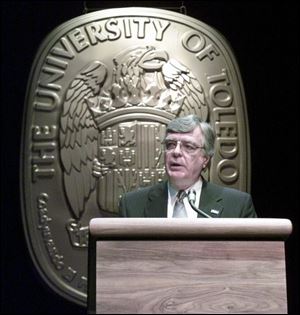
UT chief offers plans, laments Ohio cutbacks
2/7/2002
`The state of Ohio is telling us through its actions that higher education is not a high priority,' says UT's president, Daniel Johnson.
The University of Toledo has made positive strides in the last year, but it remains in a “state of need,” President Daniel Johnson said yesterday in his State of the University address.
Possibly the greatest challenge facing the institution is the decline in resources from the state, which reduced funding to state colleges by 6 percent in the fall, Dr. Johnson said.
“The state of Ohio is telling us through its actions that higher education is not a high priority,” he told an audience of about 500 people in UT's Doermann Theater.
This was the first State of the University address for Dr. Johnson, who took the helm at UT in July. His remarks lasted about 35 minutes.
State budget cuts have led to proposals for large tuition increases at some state schools, including talk of a 35 percent hike for new students at Ohio State University. The rising cost of health-care benefits and wages, combined with the prospect of continued state reductions, could cause a budget gap of $14 million at UT next year, Dr. Johnson said.
As a metropolitan, open-admissions university, UT must be careful about how it adjusts its tuition to accommodate these factors. Officials are seeking alternative revenue sources and expect to have a budget outline ready by the end of the month, he said.
“We must be careful not to limit access by pricing a UT degree out of the reach of ordinary families in our community and region,” the president explained. “We must not allow our current budgetary pressures - as real as they are - to discourage us.”
Dr. Johnson spent considerable time discussing the values that are at the core of metropolitan universities, including academic freedom, diversity, and shared governance.
“Our shared values will be the anvil on which we forge our vision of the future of the University of Toledo,” he said.
The president, who has written about urban universities, often has spoken of the need for UT to interact more with the surrounding region.
“My personal vision is grounded in a deep conviction that the future of northwest Ohio depends upon this university being a strong institution that provides high-quality academic programs,” he said.
Other challenges facing UT that Dr. Johnson noted include recruiting and retaining students, finding the right balance between athletics and academics, and dealing with the rapidly changing demographics of society.
Numerous listeners had strong reviews for the speech, though some said they were looking for more answers to the challenges described. “I heard a lot of issues. I would like to have heard some solutions, especially on shared governance,” said Erik Johanson, associate professor of music.
Jim Larson, a former UT associate professor and founder of a neighborhood group called the Ottawa Coalition, said Dr. Johnson has his heart in the right place, though his efforts appear handcuffed by funding issues.
“I thought for years the university needed to take up its urban mission, and finally we have a president who's willing to do that,” he said. “I thought he spoke very honestly.”